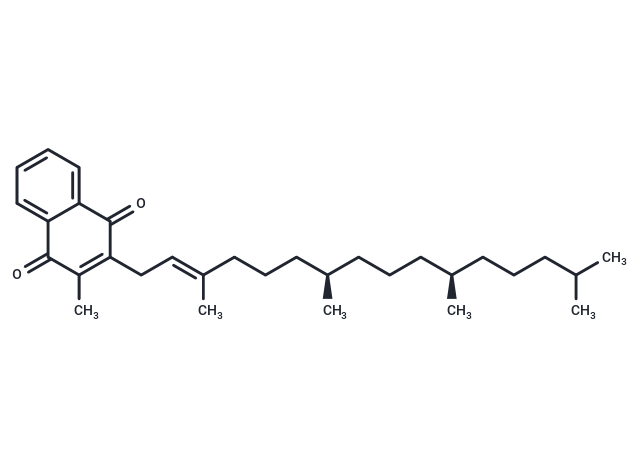Shopping Cart
- Remove All
 Your shopping cart is currently empty
Your shopping cart is currently empty

Vitamin K1 (Phylloquinone) a fat-soluble, naturally occurring vitamin with antihemorrhagic and prothrombogenic activity.

| Pack Size | Price | Availability | Quantity |
|---|---|---|---|
| 1 g | $37 | In Stock | |
| 5 g | $97 | In Stock | |
| 1 mL x 10 mM (in DMSO) | $29 | In Stock |
| Description | Vitamin K1 (Phylloquinone) a fat-soluble, naturally occurring vitamin with antihemorrhagic and prothrombogenic activity. |
| In vitro | Phylloquinone, also known as vitamin K1, is a vital compound produced solely by plants, green algae, and some cyanobacteria. It functions importantly in photosynthesis as an electron carrier in photosystem I and aids in forming protein disulfide bonds. Beyond its plant-based roles, phylloquinone is crucial for blood coagulation, bone, and vascular health in humans and other vertebrates, with green leafy vegetables and vegetable oil being its primary dietary sources[1]. Therapeutically, vitamin K1 exhibits a notable antiproliferative effect and induces apoptosis in specific cancer cell lines such as Caco-2, HT-29, and SW480, likely through the MAPK pathway, while also significantly reducing polyamine biosynthesis[2]. |
| In vivo | Subjects who augmented their dietary vitamin K intake during the follow-up exhibited a 51% lower risk of developing diabetes compared to those who reduced or maintained their phylloquinone (vitamin K) consumption [3]. Furthermore, vitamin K supplementation countered bone deterioration in mice on a high-fat diet by modulating osteoblast and osteoclast activities, thereby preventing bone loss [4]. Additionally, topical application of vitamin K1 on skin has been effective in reducing pigmentation and resolving bruising, demonstrating significant improvement in wound healing, epithelialization time, hydroxyproline content, and tensile strength when compared to the control group [5]. |
| Cell Research | Caco-2, HT-29, and SW480 cells are treated with increasing concentrations of vitamin K1 (10, 50, 100, and 200 μM) for 24 h, 48 h, and 72 h. MTT is added to each dish and incubated for 2 h at 37°C. At the end of the incubation period, the medium is removed. The plate is read at 570 nM[2]. |
| Alias | Phytonadione, Phytomenadione, Phylloquinone, Phyllohydroquinone |
| Molecular Weight | 450.7 |
| Formula | C31H46O2 |
| Cas No. | 84-80-0 |
| Smiles | O=C1C=2C(C(=O)C(C)=C1C/C=C(/CCC[C@@H](CCC[C@@H](CCCC(C)C)C)C)\C)=CC=CC2 |
| Relative Density. | 0.984g/mLat 25°C(lit.) |
| Storage | Powder: -20°C for 3 years | In solvent: -80°C for 1 year | Shipping with blue ice. | ||||||||||||||||||||||||||||||
| Solubility Information | DMSO: 25 mg/mL (55.47 mM), Sonication is recommended. | ||||||||||||||||||||||||||||||
Solution Preparation Table | |||||||||||||||||||||||||||||||
DMSO
| |||||||||||||||||||||||||||||||

Copyright © 2015-2025 TargetMol Chemicals Inc. All Rights Reserved.